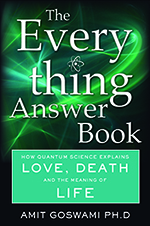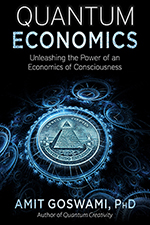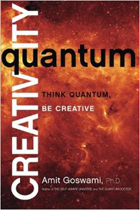If you don’t know me, I am a quantum physicist, consciousness researcher, and a quantum activist. I teach quantum activism workshops all over the world. Quantum physics has unambiguously integrated science and spirituality; I teach people to transform their lives and the world accordingly.
In quantum physics, objects are possibilities residing in a domain of potentiality outside of space and time. In this domain, no signals are required for communication; communication is instantaneous. Such instant communication is forbidden in space and time, where communication must take place through an exchange of signals that have a speed limit. Communication, you see, requires a little time for signals to travel the distance that separates the objects. In contrast, the domain of nonlocality is potential unity. Closer examination reveals that this domain of potential unity is consciousness. And the domain of space and time is what consciousness experiences by becoming immanent and separating itself into a self (subject) and the other (objects) in the process of converting potentiality into manifestation.
This is how quantum physics integrates science and spirituality. Spiritual traditions have been saying for the past five thousand years that there is a domain of reality transcending space and time, a domain where all is one. What we experience as immanent is secondary to that.
If consciousness is the nonlocal ground of being, all of our experiences—not only physical sensing, but also nonphysical thinking, feeling, and intuition—must come from it. Thinking brings meaning back in science; intuitions bring back purpose such as love; and feelings bring back passion in our exploration of meaning and purpose.
People come to my workshops because they have a real hunger for meaning and purpose in their lives. This is partly a consequence of the prevalent worldview of scientific materialism—the idea that everything is matter and the play of material interactions. In that view, the concept of information—other people’s meaning—dominates ordinary people’s psyches. And according to these elitists who dictate people’s experiences of meaning (or lack of it), the world is seen as mechanical and cause-driven with no purpose.
This should not be so bad because there is the other worldview—religion—and religions ought to be providing people with some sense of meaning and purpose. Wherefrom religion? There was a time when the spiritual traditions did not sit well with ordinary people; religions are popularized versions of the spiritual traditions. Unfortunately, especially in the West, religion gives a confusing message. It does not reject purpose entirely; but it propounds that the ultimate purpose of human life is to strive for living in perfection—in the company of an entity separate from us called “God.” God is transcendent—outside of space and time; that’s the part Western religions emphasize. We cannot go to God’s abode—heaven—unless we earn virtues, so there is purpose. But the fruit of our actions arrive only when we die. In this way, religions tend to be world-negating, even life-negating; not appropriate for people of a time when after hundreds of years of science and over a century of mass technology, we have finally learned to cope with the environment to a large extent. There is happiness in the world and life after all! Not only from material pleasures but also from the immanent spirit.
By reaffirming that God is available and immanent also in the world and in us and also giving us the means of exploring our God-ness, the quantum worldview points to a middle path between world-affirming but God-negating materialist science and God-affirming but world-negating religion.
Thus, in this essay I declare: the meaning and purpose of life for most people is served best if they adopt this middle path consisting of integrating science and spirituality in their lives, exploring meaning and purpose, achieving integration, inclusivity, and wholeness, and living and serving in the world in a flow, balanced and harmonized between the world and immanent God, the spirit.
Am I proposing a new religion? Categorically, no. I am proposing a new way of living. It is not a coincidence that the idea of this new form of spiritual living integrated with science came to me while I was teaching a quantum activism workshop on life management—how to manage your life using the quantum principles and worldview. The thirty plus participants of the workshop were co-discoverers with me.
The Stuff to Integrate and Arrive at Wholeness
The idea of immanent spirit is not entirely new. What is new is the integration: we do not leave the transcendent out either.
The exploration of wholeness in our lives can begin at many levels. The traditional spiritual motivation is to integrate the three major dichotomies. Read what Jesus said two thousand years ago:
When you make the two one,
and when you make the inner as the outer
and the outer as the inner,
and the above as the below,
and when you make
the male and the female into a single one
so that the male will not be male
and the female not be female,
then shall you enter the Kingdom.
(Gospel according to Thomas)
The kingdom is the kingdom of heaven, of course. Above and below stand for transcendent and immanent — what in quantum science we call nonlocal (where communication is without signals) and local (where communication requires signals). Inner refers to our internal experiences of feeling, thinking and intuiting. Outer refers to our external experiences of sensing. Jesus’ emphasis is clear though: entering heaven is the goal of the integration of the dichotomies. And this is what I am proposing: We de-emphasize. For us of quantum spirituality, the integration of these fundamental dichotomies is important because it leads to wholeness.
In quantum activism and in the institutes of transformative education that my friends and I have founded, we emphasize achieving congruence of thinking, living, and making livelihood to arrive at wholeness.
Thinking refers to the worldview that you are using to think. Believe me, whether you are aware or not, you — we all — wear a lens to see the world around us, and that is our worldview.
Living refers to how we experience our lives. Scientific materialists try to sell the idea that we are robots, determined machines; we live programs built into us by evolution, the genes, and some role is allowed to our socio-cultural environmental upbringing too. Robots can sense stimuli, operate programs in response, and can process information. Materialists therefore emphasize sensing, the negative emotional brain circuits, the brain circuits of pleasure, and information processing.
But of course, pragmatic people, even materialists don’t actually live this way especially, the elites. They process meaning, even feelings, like that of romance; only, they claim it is pretend. They may even believe that. That philosophy—our nonphysical experiences are pretend experiences, by the way, is called existentialism.
In the quantum worldview, all our experiences are scientific, not just sensing and information processing. We feel, think, intuit — the whole gamut. We are not robots; we can be creative. Our dreams have meaning. We even process in our unconscious. This full scope of living can only be realized if you think with a wider lens. Now do you see? This is why you need the quantum worldview by which to think.
What else do we need to integrate to achieve wholeness? Thinking and feeling. Culturally, men emphasize the former while women are cultivated to emphasize the latter as well. These cultural emphases are personally interesting because for a long time I thought that the neocortex was the only place where we experience a self separate from the object that we are experiencing. The neocortex is built to process mental meaning. So, I thought that we could not experience feeling without thoughts. Feeling plus thought is called emotion. Our common experiences of feeling are indeed via emotions.
But you know what. I know better now. In 1983, I was attending a workshop by the physician/spiritual teacher Richard Moss. Richard himself with his colleagues gave each one of us a “chakra healing.” Chakras are supposed to be points along our spine where we experience feelings. Well, afterwards, there was a session, and some of the participants (there were twenty-six of us), began sharing their experiences in glorious terms. I, who had hardly any experience, felt totally left out. Like, “What am I doing here?” Finally, I could not hold it any longer and raised my hand.
“Yes, Amit.”
“Richard, looks like you gave all these experiences to all these people, why not me? “
Richard said, “Amit, I can only open the door for you. It is you who has to pass through it.”
“Sounds well and dandy. So you are saying all these people passed through the door and I chose not to.”
“That’s for you to decide. All these people left their selves at the door. That’s the trick. Then you enter.”
“But I am a scientist. I want to be there when it happens.” I blurted out.
Everybody was laughing — LOL in today’s language. And I realized my mistake. In the next few days I received ample doses of Richard’s prescription medicine—juicy physicality consisting of intimate hugs, especially from women. After that and a few more sessions of chakra healing, I got it. I could experience energy in my chakras.
But. It is undoubtedly true that experiences come with two poles: subject and object, self and the other. If you don’t see this, meditate. In mindfulness meditation, you can easily see yourself (your “I”) looking at thoughts in your internal sky. Of course, your looking has converted the “I” you are looking at into a “me,” but the “you” that is looking at the “me” has an implicit flavor of “I.” Got it? The confusion is created because ordinarily our “I” experience gets mixed up with the “me.” What we call our ego is really I/me. If you persevere in mindfulness meditation and always try to look for the I that is looking at the I/me looking at the I/me ad infinitum, occasionally you will fall into a state that is unmistakably pure “I.” And then all your doubts will be resolved.
I know, I have such experiences of pure I regularly. Many people do. It is now even codified. Researchers Daniel Goleman and Richard Davidson have written a book on long-term meditators, Altered Traits, whose brain imaging clearly demonstrate the distinction that they are experiencing pure “I” rather than the I/me of the ego much of the time. This pure I is called the inner self in spiritual traditions (antaratman in Sanskrit), the transpersonal self in transpersonal psychology, and in the quantum worldview, we call it the quantum self.
The book that put me on the map of consciousness research, The Self-Aware Universe, has all the details of how the understanding of quantum physics leads us to the explanation of how the brain—the neocortex—gets to have a self. I will not discuss the theory here. But suffice it to say, at first, I could not see any such way of understanding a self in any of the chakras to qualify them as places where you have a self and have experiences of pure feeling.
But those brain scientists, well, you have got to give them credit. Recently, believe it, they have discovered two little brains in the body, one at the navel, the other at the region of the heart, exactly where two of the major chakras are supposed to be located.
“Aha,” thought I in a creative surprise. There are selves in the body after all; selves of pure feeling. The mechanism that gives the neocortex a self is available also at the navel and at the heart chakra. The selves there are weak to be sure; the brain self overwhelms them no doubt in the ordinary course of life. But when intuitions come to them, many men talk about their “gut” feeling and many women talk about “knowing” with their heart. So there! these selves are not totally unfamiliar to us.
Okay; so, there is another thing to integrate: the selves. Are there more? I brought up intuitions above. What do we intuit? The objects of intuition are so subtle that we explore them only through our thoughts and feelings about them, not in their suchness. So, we call them archetypes following Plato, elevated contexts of thinking and feeling.
An example will make the situation clear. Love is such an archetype. You think and talk about love every day, right? But do you know what love is for sure? It is like that Joni Mitchel song, isn’t it? “I have looked at love from both sides now/from up and down and still somehow/it’s love’s illusions I recall/I really don’t know love at all.”
There are nine major archetypes that concern us the most—love, of course. Then there is the archetype of abundance that businesspeople are meant to pursue. You probably think, businesspeople pursue money. But have you noticed that even if they go on making money, even to the extent of being billionaires, they are not satisfied. This is because these billionaires never feel that that they have made enough. In other words they don’t feel they achieved abundance. They are not doing it right.
You can never do it right with the archetype of abundance if money is your only goal. It is like an episode of the comic strip Pearls before Swine: The first frame, Burr (one of the human characters) says, “I am unhappy.” So he buys lottery tickets every day for ten years until he wins the lottery. Then he goes on a buying spree: cars, boat, a huge house. But a later frame shows him saying, “I am still unhappy.” And he spends the rest of his life yelling at his pile of money, “Make me happy.” The frame with the punch line is so reflective of the materialist mind set. Goat says, “There is a lesson here somewhere.” Rat says, “Probably needs a bigger house.” And pig says, “Just buy more cheese!!!”
How does a Bill Gates and others like him become philanthropists? It is because they, in contrast to most of rich people, have achieved fulfillment in their exploration of abundance by seeking not only money but also meaning, passion, even archetypes like love; they are doing the archetype of abundance full justice.
Then there is the archetype of power. Politicians and business people today seek power. They, too, tend to be an insatiable bunch, don’t they? They, too, are not doing it right. They seem mainly to seek power to empower themselves, not to share it or to empower others.
The same story goes for the five other major archetypes: truth, beauty, justice, goodness, and wholeness. (Self is the chosen archetype for monks, sadhus, and other renunciates. But we don’t call them professionals, do we?) Under the worldview polarization between religion and materialist science, the professions humans pursue have become so out of synch with their intended archetypes that only a few people can find satisfaction with their professional pursuits anymore.
So, in quantum activism, we also emphasize changing the professional world so that one can earn a living in synch with quantum thinking and quantum living.
The sad truth is, most people today are caught up in the perception of a dichotomy in the archetypes themselves. I will follow-up with an examination of the archetypes next month. See you then!



